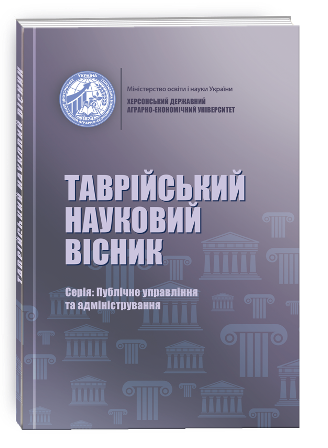THE EFFECTIVENESS OF PUBLIC ADMINISTRATION IN THE TRANSFORMATION OF THE ECONOMIC SYSTEM OF UKRAINE
DOI:
https://doi.org/10.32851/tnv-pub.2021.2.4Keywords:
public administration, result, transformation, economic system, structureAbstract
The necessity of taking effective forms of management of the process of transformations of the national economy of Ukraine is determined. The efficiency of public management of economic processes based on the principles of integrity, coherence, openness, democracy, variability, optimality is proved. The principles of formation of the model of transformations of the economic system of Ukraine and its constituent elements are determined. The density of interrelations between the components of the economic system and the form of connections is established. In the course of the research it was determined that the application of the principles of public administration brings the economic system to a new level of existence and promotes the formation of a synergetic model of its transformations. Modern conditions of transformation of the national economy require consideration of the principles of organization and selforganization, which actualizes the principles of public administration: legality, objectivity, democracy, science, efficiency, publicity, separation of powers. It is established that mathematical modeling of the process of transformation of Ukraine’s economy should be carried out using a systematic approach, which allowed to consider the object of study as a system that is a set of interacting indivisible elements, which should be managed on the basis of law and publicity. The transformation of the national economy is a complex process, and its course leads to its irreversible qualitative development. In terms of research, the internal structure of the national economy is of great interest from the standpoint of changing it over time and establishing the decisiveness in this case of the factor of public administration. The experience gained in this area of application of such models shows their importance in the process of determining macroeconomic patterns, as well as the possibility of their use to predict the likely consequences of macroeconomic decisions while maintaining existing relationships. The synergetic nature of the effectiveness of public management of transformations of the economic system of the components of the transformation model is proved. The degree of effectiveness of public management of the transformation of the economic system of Ukraine is determined, which is proved by the actual indicators of efficiency of the national economy.
References
Капица С.П., Курдюмов С.П., Малинецкий Г.Г. Синергетика и прогнозы будущого. Київ : 2003 257 с.
Левашов В.К. Глобализация и устойчивое развитие. Устойчивое развитие. Наука и Практика. 2002. № 1. С. 19–38.
Леонтьев В. Исследования структуры американской экономики. Москва: Прогресс, 1958. 720 с.
Лесков Л.В. Постижение непредсказуемого: бифуркационное пространство XXI века. Общественные науки и современность. 2001. № 6. С. 167–175.
Петров Л.Ф. Методы нелинейной динамики как инструменты управления экономической эффективностью. С. 1–11. URL: http://www.info.e-c-m.ru/UER_23_03_2011.pdf.
Потравка Л.О. Модель трансформацій аграрного сектора України. Науковий вісник Міжнародного гуманітарного університету. Серія: Економіка і менеджмент. 2016. Вип. 20. С. 40–46.
Потравка Л.О. Оцінка синергетичного ефекту структурних трансформацій агропродовольчого сектора України. Вісник Одеського національного університету ім. І.І. Мечникова. 2015. Вип. 19. Т. 20. С. 71–74.
Nemchenko D., Kobets V., Potravka L. Neuro-fuzzy model of development forecasting and effective agrarian sector transformations of Ukraine. CEUR Workshop Proceedings. 2018. 2104, P. 84-99.






